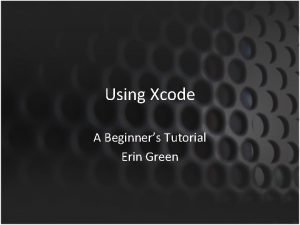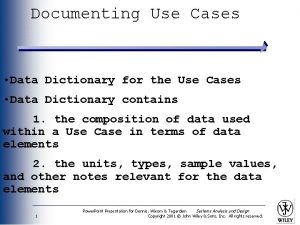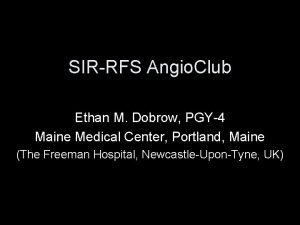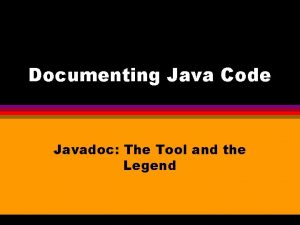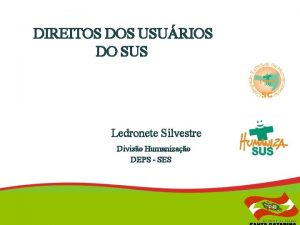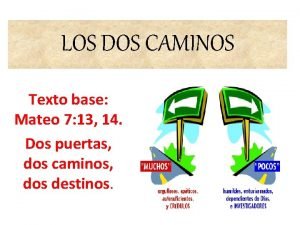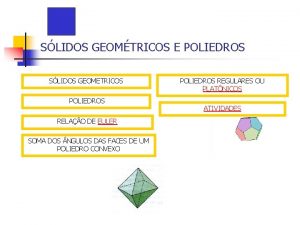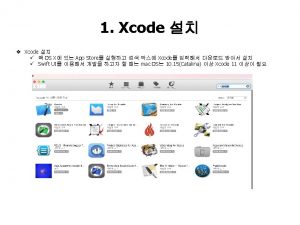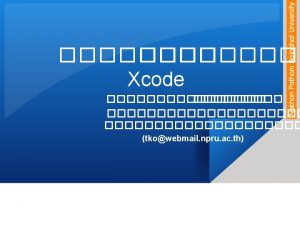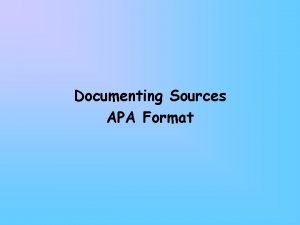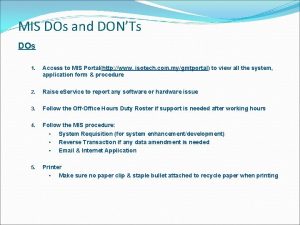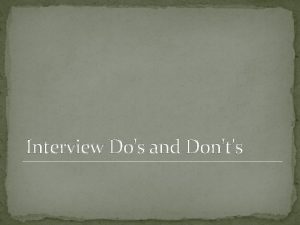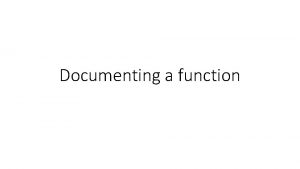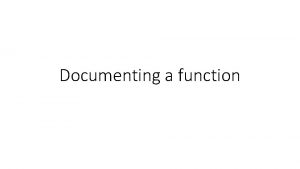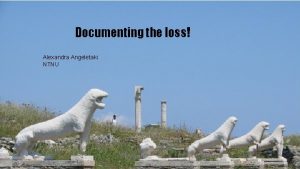Documenting in Xcode Dos and Donts Using Header























- Slides: 23

Documenting in Xcode: Do’s and Don’ts Using Header. Doc to make complete documentation as Html file. By Naveed Khalid

File Header Comment // // File Name. ext Project Name Created by <Author Name> on dd/mm/yyyy. Copyright 2014 (c) <Company Name>. All rights reserved.

Header. Doc Comment Header. Doc is a tool that you can run from the command-line. Basically it scans your files for comments made in a particular style. Following that particular style will help in documentation on the go! Which particular style?

Header. Doc Comment Three styles of comments that Header. Doc scans for: Option 1: /// Your documentation comment will go here Option 2: /** * Your documentation comment will go here */ Option 3: /*! * Your documentation comment will go here */

Header. Doc Comment These are similar to “normal” comments, except that there’s an extra / in option 1, and Three styles of comments that Header. Doc for: anscans extra character in the first line of options 2 Option 1: /// Your documentation comment will go here and 3 (* and !, respectively). Option 2: /** * Your documentation comment will go here */ Option 3: /*! * Your documentation comment will go here */

Best Way? For single line comments, use the triple forward slash syntax (///) For multiline comments, use the style used in Apple’s documentation (/*!)

Header. Doc Tags? A tag starts with the @ symbol and a keyword, followed by a space, and a string that contains a description relative to that keyword (such as @param foo). Top-Level Tags: These are tags that declare the type of thing you are commenting (Headers, classes, methods, etc). An example of a top-level tag is @typedef. Second-Level Tags: These tags help to give more detail about the specific thing you are commenting. Such as @brief, @abstract etc.

Some Second-level Tags @abstract A short string that briefly describes anything. This should not contain multiple lines @brief Equivalent to @abstract. Provided for better Doxygen compatibility. @discussion A block of text that describes a function, class, header, or data type in detail. @param The name and description of a parameter to a function @return Describes the return values expected from this function. Don't include if the return value is void @result Same as @return

Classes, Protocols, and Interfaces Example of @class tag in Objective-C /*! @class my. Class @inherits Base class @conforms List of protocol name those this class conforms to @discussion This is a discussion. It can span many lines or paragraphs. */ @interface my. Class : NSObject @end

Classes, Protocols, and Interfaces Example of @protocol tag in Objective-C /*! @protocol my. Protocol @discussion This is a discussion. It can span many lines or paragraphs. */ @protocol my. Protocol @end

Classes, Protocols, and Interfaces Example of @category tag in Objective-C /*! @category my. Main. Class(my. Category) @discussion This is a discussion. It can span many lines or paragraphs. */ @interface my. Main. Class(my. Category) @end

Documenting Methods /*! * @discussion A really simple way to calculate the sum of two numbers. * @param first. Number An NSInteger to be used in the summation of two numbers * @param second. Number The second half of the equation. * @return The sum of the two numbers passed in. */

Warnings To inform about add a @warning tag. Add the following text just above the @return tag: * @warning Please make note that this method is only good for adding non-negative numbers.

Documenting Property Example of @property tag /*! @property Property name @brief The View. Controller class' car object. */

Documenting Variables Example of @var tag /*! @var we_are_root @abstract Tells whether this device is the root power domain @discussion TRUE if this device is the root power domain. For more information on power domains. . */ bool we_are_root;

Documenting Constants Example of @const tag /*! @const k. CFType. Array. Call. Backs @abstract Predefined CFArray. Call. Backs structure containing a set of callbacks appropriate. . . @discussion Extended discussion goes here. */ const CFArray. Call. Backs k. CFType. Array. Call. Backs;

Documenting Enumeration Example of @enum tag /*! @enum Enumeration name @discussion Detail description of enum */

Documenting Enumeration /*! * @typedef Old. Car. Type * @brief A list of older car types. * @constant Old. Car. Type. Model. T A cool old car. * @constant Old. Car. Type. Model. A A sophisticated old car. */ typedef enum { Old. Car. Type. Model. T, Old. Car. Type. Model. A } Old. Car. Type;

Documenting Enumeration typedef enum { /// A cool, old car. Old. Car. Type. Model. T, /// A sophisticated older car. Old. Car. Type. Model. A } Old. Car. Type;

Adding Formatted Code /*! * @brief The car will drive, and then execute the drive block * @param completion A drive. Completion block * @code [car drive. Car. With. Completion: ^(CGFloat distance){ NSLog(@"Distance driven %f", distance); }]; */

Other Comments // FIXME: This is broken // !!!: Holy cow, it should be checked! // ? ? ? : Perhaps check if the block is not nil first?

Code Snippet for comments /*! * @discussion <#description#> * @param <#param description#> * @return <#return description#> */

Finalizing: Creating Html Open terminal cd /path/to/your/folder headerdoc 2 html -o ~/Desktop/destination. Folder source. Folder/ Now to create a Master TOC cd ~/Desktop/documentation gatherheaderdoc.
 Dos and donts of netiquette
Dos and donts of netiquette Dos and donts infographic
Dos and donts infographic The do's & don'ts of online communication.
The do's & don'ts of online communication. Email format for professor
Email format for professor Netiquette summary
Netiquette summary Ip header vs tcp header
Ip header vs tcp header Understanding and documenting iso 26000 training
Understanding and documenting iso 26000 training Xcode tutorial for beginners
Xcode tutorial for beginners Umarket umn
Umarket umn Text donts
Text donts Xcode change app icon
Xcode change app icon Documenting use cases
Documenting use cases Narrative documentation
Narrative documentation Week by week plans for documenting children's development
Week by week plans for documenting children's development Sir rfs
Sir rfs Documenting java code
Documenting java code Header and footer
Header and footer Dos moviles parten en el mismo sentido a 10m/s y 30m/s
Dos moviles parten en el mismo sentido a 10m/s y 30m/s Los 2 reyes y los 2 laberintos
Los 2 reyes y los 2 laberintos Defesa dos direitos dos usuários pnh
Defesa dos direitos dos usuários pnh El que habla dos idiomas vale por dos
El que habla dos idiomas vale por dos Camino estrecho biblia
Camino estrecho biblia Los envió de dos en dos
Los envió de dos en dos Nomes de sólidos geométricos
Nomes de sólidos geométricos







